Transthyretin (TTR) In Amyloid Diseases
What is transthyretin?
Transthyretin (TTR), previously called “prealbumin,” is a protein that transports thyroxine and retinol. It is synthesized in the liver, found mainly in plasma, and makes up a major component (25%) of cerebrospinal fluid (CSF).1 It is also found in the vitreous humor of the eye, but does not cross the blood-brain barrier.2
Transthyretin Structure
Transthyretin is a 55 kDa protein that is a native homotetramer with two thyroxine-binding sites in
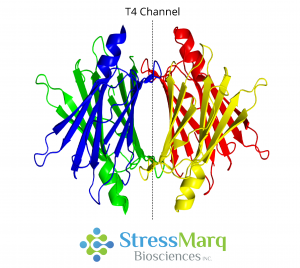
Transthyretin Tetramer with T4 Thyroxine Binding Channel
a 50 Å channel located at the center of the molecule.3 Two monomers join edge-to-edge via hydrogen bonding to form a dimer.2 Two dimers then join to form a tetramer via hydrophobic interactions.3
Transthyretin in Diseases
Transthyretin can aggregate into fibrils and get deposited in the heart (cardiomyopathy) and nervous system (neuropathy). This is known as transthyretin amyloidosis. There are several variations, depending on where the TTR gets deposited and whether the disease is familial.
- Familial Amyloid Polyneuropathy (FAP) is associated with the V30M mutation and is inherited in an autosomal dominant pattern. It is caused by the accumulation of TTR amyloid around peripheral nerves.2 The average age of onset is in the fourth decade of life.2
- Familial Amyloid Cardiomyopathy (FAC) is caused by the accumulation of TTR in the heart, and is associated with a variety of mutations.
- Senile Systemic Amyloidosis (SSA) is similar to FAC, but is caused by the accumulation of WT TTR rather than mutant TTR.4 The age of onset is usually over 60, and over 25% of people over the age of 80 have cardiac deposition of WT TTR.5 This deposition leads to heart failure.
Mechanisms of TTR Aggregation
TTR aggregation is thought to begin with the tetramer dissociating into monomers, which are prone to misfolding and self-aggregation.6 This aggregation occurs in acidic conditions similar to those found in lysosomes.7,8 The misfolded monomers assemble into fibrils via oligomers and protofibrils.9 The rate-limiting step is the tetramer disassembly; therefore, fibril formation rates are determined by tetramer dissociation rates.10

Transthyretin Misfolding and Aggregation Mechanism
Not all monomers continue on the path to aggregation; they can also refold properly and combine to form dimers, which then associate to form tetramers.11
TTR Mutations and Aggregation
Factors that promote TTR tetramer dissociation and monomer aggregation can be better understood by investigating the effects of both disease-causing and protective mutations. Over 100 TTR mutations are known to be amyloidogenic.12 There is a “hot spot region” between amino acid residues 42 and 58, but amyloidogenic mutations can span the entire protein.13,14 The V30M mutation, common in Portuguese, Swedish, and Japanese populations, is associated with autosomal dominant familial amyloid polyneuropathy. The V30M TTR tetramer is less stable than the WT TTR tetramer, but dissociates into monomers more slowly.10 This slow dissociation rate is associated with low disease penetrance that increases with age.15 V30M TTR aggregation is also influenced by the rate at which unfolded monomers can refold into dimers and tetramers. The rate of refolding is slow, which leads to the accumulation of monomers than then form fibrils.16
The L55P mutation is rare, but produces aggressive amyloidosis with severe pathology. This is because the L55P mutation lowers the activation barrier for the dissociation of a tetramer to monomer, which allows for dissociation under physiological conditions.17 This lowering of the activation barrier occurs because the starting tetrameric state is destabilized to a greater extent than the transition state.10
Conversely, the T119M mutation is protective against amyloidosis; individuals with both the V30M and T119M mutations do not develop FAP.18 This is mirrored by T119M TTR’s reluctance to aggregate in solution when combined with V30M TTR.18 T119M tetramers are very slow to dissociate due to an increased activation barrier that prevents tetramers from dissociating into monomers.19 This activation barrier is the result of a stabilized quaternary structure of the tetramer and a destabilized dissociative transition state.20
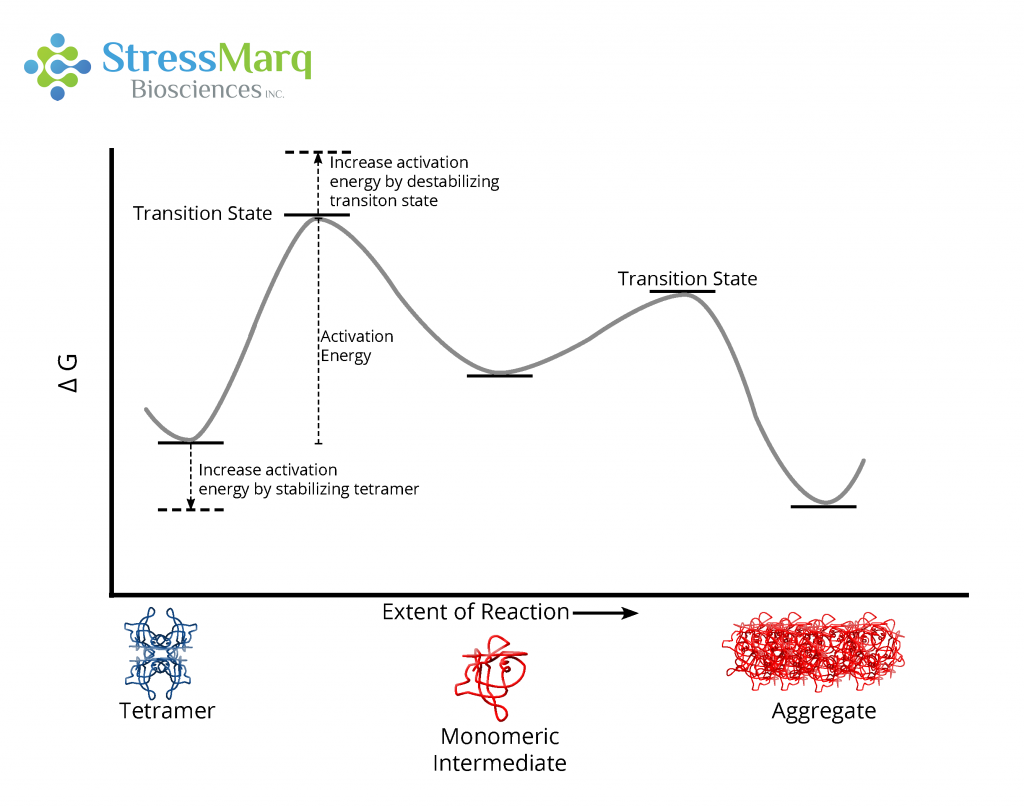
The T119M mutation prevents aggregation by increasing the activation energy required for the tetramer to dissociate into monomers.
Disease-preventing mutations, such as T119M and R104H add hydrophobic residues to the thyroxine (T4)-binding cavity, which establishes contact between amino acid residues of different dimers and prevents dissociation.21
TTR is present in the body throughout the human lifespan, but, in the absence of mutations, does not aggregate until later in life. There are a variety of aging-associated processes that could contribute to its aggregation, including oxidative stress, mitochondrial dysfunction, inflammation, and metabolic dysregulation.22
Transthyretin Toxicity
Like other diseases, the smaller TTR oligomers are thought to be more toxic than fibrils.2 These toxic oligomers are thought to be less than 100 kDa, consisting of 6-10 monomers.4,23,24 These small species can bind to lipid membranes, disrupting lipid rafts and activating voltage-gated calcium channels.24 The subsequent calcium influx can induce cytotoxicity.24
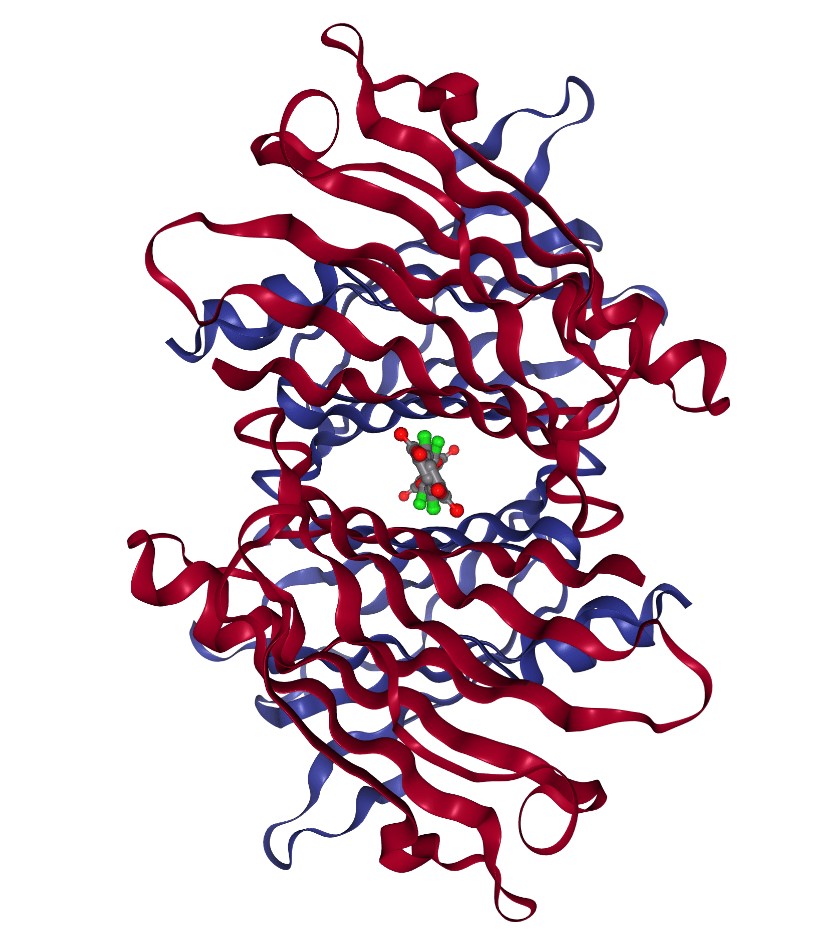
Structure of WT TTR complexed with tafamidis. Source: PDB ID: 3TCT.31
Transthyretin Fibril Seeding
Ex-vivo transthyretin fibrils have been shown to recruit WT transthyretin into aggregates.25 This seeded polymerization mechanism could provide an alternate route for TTR aggregation, and could explain why in some cases stabilizing tetramers is insufficient to prevent disease progression.25
Therapeutics Targeting Transthyretin
Because mutant TTR is synthesized by the liver, liver transplantation is used to treat familial amyloid diseases by replacing mutant TTR with WT TTR. However, sometimes TTR continues to accumulate in the heart26 and eyes.27 Tafamidis and diflunisal are TTR kinetic stabilizers that have been associated with improved survival in cardiac amyloidosis patients and function by binding in the T4 binding channel.28-30
Other therapeutic approaches include gene silencing therapies to prevent the expression of amyloidogenic mutations. Certain flavonoids and other small molecules inhibit TTR oligomerization,32-34 and doxycycline combined with Tauroursodeoxycholic acid (TUDCA) has been shown to disrupt TTR fibrils in mouse models.35 Immunization with Y78F mutant TTR has also been shown to reduce TTR deposition in transgenic mice.36
Transthyretin Fibrils
StressMarq offers L55P and Y78F mutant TTR monomers and filaments for researchers to study the mechanisms of TTR aggregation and methods to inhibit fibrillization and reduce toxicity.
References
- Herbert, J., Wilcox, J.N., Pham, K.T., Fremeau, R.T., Jr., Zeviani, M., Dwork, A., Soprano, D.R., Makover, A., Goodman, D.S., Zimmerman, E.A., Roberts, J.L., Schon, E.A. Neurology 1986, 36(7):900-911.
- Hou, X., Aguilar, M., Small., D. Transthyretin and familial amyloidotic polyneuropathy. FEBS Journal 2007, 274:1637-1650.
- Blake, C.C., Burridge, J.M., Oatley, S.J. X-ray analysis of thyroid hormone binding to prealbumin. Biochem Soc Trans 1978, (6):1114–1118.
- Faria, T.Q., Almeida, Z.L., Cruz, P.F., Jesus, C.S.H., Castanheira, P., Brito, R.M.M. A look into amyloid formation by transthyretin: aggregation pathway and a novel kinetic model. Phys Chem Chem Phys. 2015, 17(7255):7255-7263.
- Herbert, J., Wilcox, J.N., Pham, K.T., Fremeau, R.T., Jr., Zeviani, M., Dwork, A., Soprano, D.R., Makover, A., Goodman, D. S., Zimmerman, E. A., Roberts, J.L., Schon, E.A. Transthyretin: a choroid plexus-specific transport protein in human brain. Neurology 1986, 36(7):900-911
- Dobson CM. Principles of protein folding, misfolding and aggregation. Semin Cell Dev Biol. 2004, 15(1):3–16.
- Kelly, J.W., Colon, W. Partial denaturation of tranthyretin is sufficient for amyloid fibril formation in vitro. Biochemistry 31:8654-8660
- Schwarzman, A.L., Tsiper, M., Wente, H., Wang, A., Vitek, M.P., Vasiliev, V., Goldgaber, D. Amyloidogenic and anti-amyloidogenic properties of recombinant transthyretin variants. Amyloid 11(1):1-9.
- Quintas A, Vaz DC, Cardoso I, Saraiva MJ, Brito RM. Tetramer dissociation and monomer partial unfolding precedes protofibril formation in amyloidogenic transthyretin variants. J Biol Chem 2001, 276(29):27207–27213.
- Hammerstrom, P., Jiang, X., Hurshman, A.R., Powers, E.T., Kelly, J.W. Sequence-dependent denaturation energetics: A major determinant in amyloid disease diversity. PNAS. 2002, 99(4): 16427-16432.
- Jesus, C.S.H., Vaz, D.C., Saraiva, M.J.M., Vrito, R.M.M. The V30M Amyloidogenic Mutation Decreases the Rate of Refolding Kinetics of the Tetrameric Protein Transthyretin. Spectroscopy. (2012). 27(5-6):343-348.
- National Library of Medicine (US). Genetics Home Reference [Internet]. Bethesda (MD): The Library; 11 June 2019. TTR gene. [reviewed 2009 Jan; cited 20 June 2019]. Available from: ghr.nlm.nih.gov/gene/TTR.
- Saraiva, M. Transthyretin mutations in health and disease. Human Mutation 1995, 5:191-192.
- Kelly, J.W., Lansbery, P.T. Jr. A chemical approach to elucidate the mechanism of transthyretin and b-protein amyloid fibril formation. Amyloid 1994, 1:186-205
- Hellman, U., Alarcon, F., Lundgren, H.E., Suhr, O., Bonaiti-Pellie, C., Plante-Bordeneuve, V. Heterogeneity of penetrance in familial amyloid polyneuropathy, ATTR Val30Met, in the Swedish population. Amyloid 2008, 15(3):181-186.
- Jesus, C.S.H., Vaz, D.C., Saraiva, M.J.M., Vrito, R.M.M. The V30M Amyloidogenic Mutation Decreases the Rate of Refolding Kinetics of the Tetrameric Protein Transthyretin. Spectroscopy 2012, 27(5-6):343-348.
- Lashuel, H.A., Wurth, C., Woo, L., Kelly, J.W. The most pathogenic transthyretin variant, L55P, forms amyloid fibrils under acidic conditions and protofilaments under physiological conditions. Biochem 1999, 38(41):13560-73.
- Coelho, T., Chorao, R., Sousa, A., Alves, I., Torres, M.F. and Saraiva, M.J.M. Compound heterozygotes of transthyretin Met30 and transthyretin Met119 are protected from the devastating effects of familial amyloid polyneuropathy. Disord. 1996, 6:27-32.
- Sun, X., Dyson, H.J., Wright, P.E. Kinetic analysis of the multistep aggregation pathway of human transthyretin. Proc Natl Acad Sci USA, 2018, 115(27):E6201-6208.
- Hammarstrom P, Schneider F, Kelly JW. Trans-suppression of misfolding in an amyloid disease. Science 2001; 293:2459-2461.
- Sant’Anna, R., Almeida, M.R., Varajao, N., Gallego, P., Esperante, S., Ferreira, P., Pereira-Henriques, A., Palhano, F.L., de Carvalho, M., Foguel, D., Reverter, D., Saraiva, M.J., Ventura, S. Cavity filling mutations at the thyroxine-binding site dramatically increase transthyretin stability and prevent its aggregation. Sci Rep 2017, 7:44709.
- Liao, R., Ward, J.E. Amyloid Cardiomyopathy – Disease on the Rise. Circ Res. 2017, 120(12):1865-1867.
- Reixach, N., Deechongkit, S., Jiang, X., Kelly, J. W. & Buxbaum, J. N. Tissue damage in the amyloidoses: Transthyretin monomers and nonnative oligomers are the major cytotoxic species in tissue culture. Natl. Acad. Sci. USA 2004, 101:2817–2822.
- Hou, X. et al. Transthyretin oligomers induce calcium influx via voltage-gated calcium channels. Neurochem. 2007, 100:446–457.
- Saelices, L., Chung, K., Lee, J.H., Cohn, W., Whitelegge, J.P., Benson, M.D., Eisenberg, D.S. (2018). Amyloid seeding of transthyretin by ex vivo cardiac fibrils and its inhibition. PNAS 2018, 115(29):E6741-E6750.
- Liepnieks, J.J., Benson, M.D. Progression of cardiac amyloid deposition in hereditary transthyretin amyloidosis patients after liver transplantation. Amyloid, 2007. 14:277–282.
- Ohya Y, Okamoto S, Tasaki M, et al. Manifestations of transthyretin-related familial amyloidotic polyneuropathy: long-term follow-up of Japanese patients after liver transplantation. Surg Today. 2011, 41(9):1211–1218.
- Coelho, T., Maia, L. F., Martins da, S. A., Waddington, C. M., Plante-Bordeneuve, V., Lozeron, P., Suhr, O. B., Campistol, J. M., Conceicao, I. M., Schmidt, H. H., Trigo, P., Kelly, J. W., Labaudiniere, R., Chan, J., Packman, J., Wilson, A., and Grogan, D. R. Tafamidis for transthyretin familial amyloid polyneuropathy: a randomized, controlled trial. Neurology 2012, 79:785−792.
- Berk, J. L., Suhr, O. B., Sekijima, Y., Yamashita, T., Heneghan, M., Zeldenrust, S. R., Ando, Y., Ikeda, S., Gorevic, P., Merlini, G., Kelly, J. W., Skinner, M., Bisbee, A. B., Dyck, P. J., and Obici, L. The diflunisal trial: study accrual and drug tolerance. 2012, Amyloid 19, 37−38.
- Rosenblum, H., Castano, A., Alvarez, J., Goldsmith, J., Helmke, S., Maurer, M.S. TTR (Transthyretin) Stabilizers Are Associated With Improved Survival in Patients With TTR Cardiac Amyloidosis. Circ Heart Fail. 2018, 11(4):e004769.
- Bulawa, C.E., Connelly, S., Devit, M., Wang, L., Weigel, C., Fleming, J.A., Packman, J., Powers, E.T., Wiseman, R.L., Foss, T.R., Wilson, I.A., Kelly, J.W., Labaudiniere, R. Tafamidis, a potent and selective transthyretin kinetic stabilizer that inhibits the amyloid cascade. Proc Natl Acad Sci USA 2012, 109:9629-9634.
- Ferreira, N., Pereira-Henriques, A., Almeida, M.R. Transthyretin chemical chaperoning by flavonoids: Structure–activity insights towards the design of potent amyloidosis inhibitors. Biochem & Biophys Rep. 2015, 3:123-133.
- Yokoyama, T., Takaki, S., Chosa, K., Sato, T., Suico, M.A., Teranishi, Y., Shuto, T., Mizuguchi, M., Kai, H. Structural stabilization of transthyretin by a new compound, 6-benzoyl-2-hydroxy-1H-benzo[de]isoquinoline-1,3(2H)-dione. J Pharmacol Sci 2015, 129(4):240-3.
- Jono, H., Anno, T., Motoyama, K., Misumi, Y., Tasaki, M., Oshima, T., Mori, Y., Mizuguchi, M., Ueda, M., Shono, M., Obayashi, K., Arima, H., Ando, Y. Cyclodextrin, a novel therapeutic tool for suppressing amyloidogenic transthyretin misfolding in transthyretin-related amyloidosis. Biochem J 437(1):35-42.
- Cardoso, I., Martins, D., Ribeiro, T., Merlini, G., Saraiva, M.J. Synergy of combined Doxycycline/TUDCA treatment in lowering Transthyretin deposition and associated biomarkers: studies in FAP mouse models. J Transl Med 2010, 8:74.
- Terazaki, H., Ando, Y., Fernandes, R., Yamamura, K., Maeda, S., Saraiva, M.J. Immunization in familial amyloidotic polyneuropathy: counteracting deposition by immunization with a Y78F TTR mutant. Lab Inv. 2006), 86:23-3

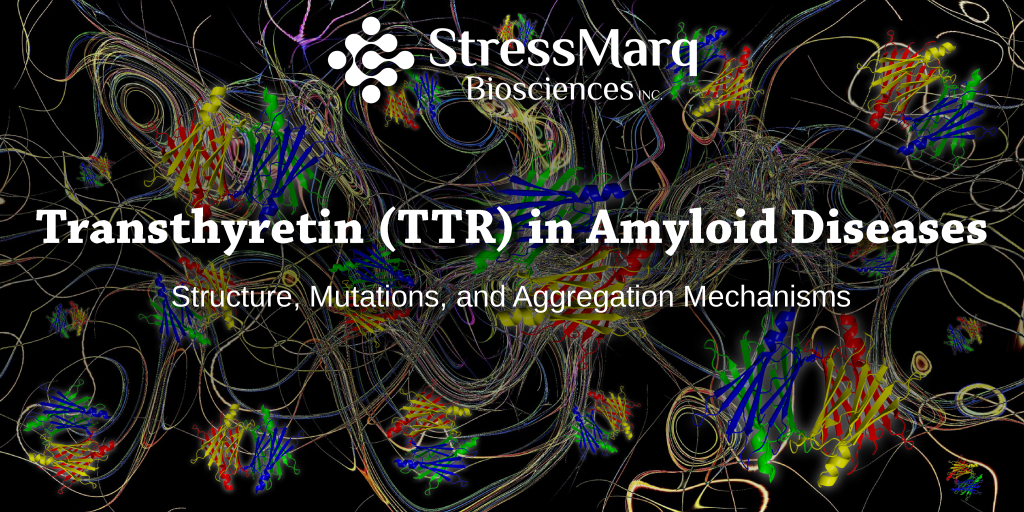
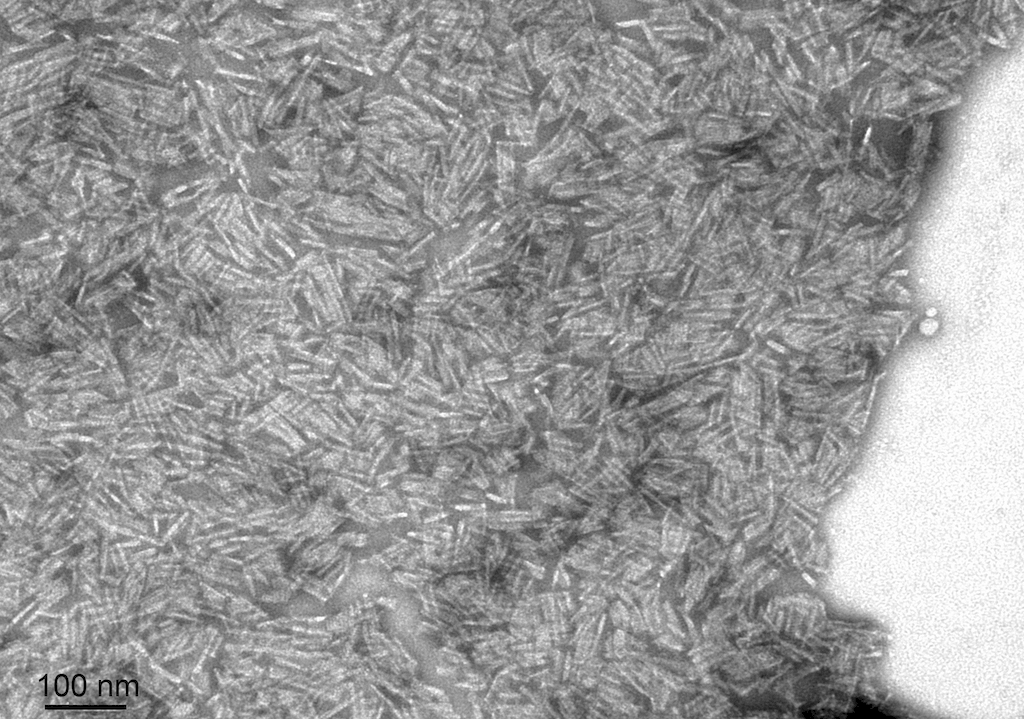
Leave a Reply